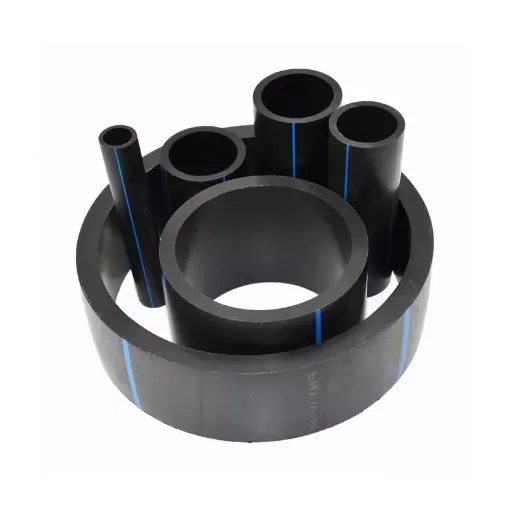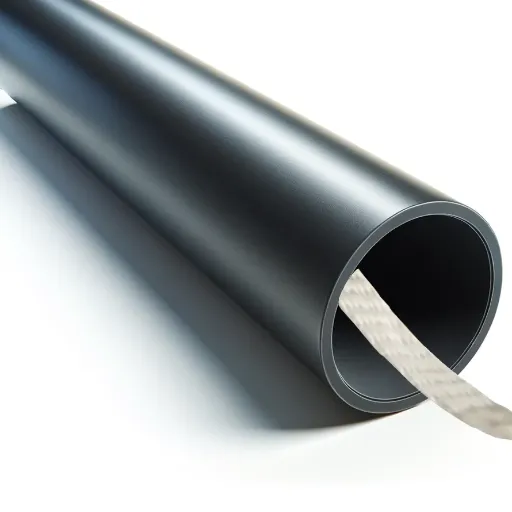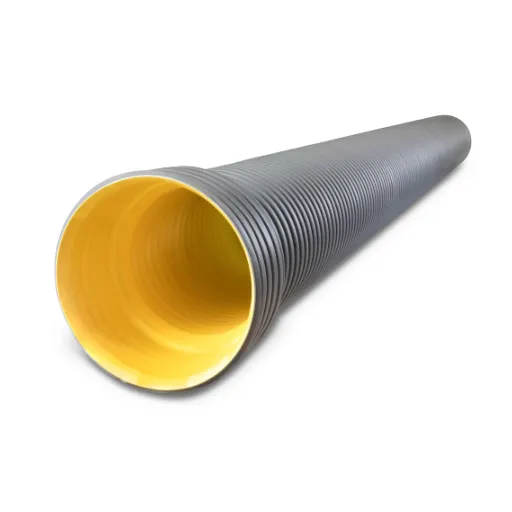In modern plumbing and heating systems, adaptability, durability, and efficiency are the principal elements 1-2 inch PEX pipes guarantee. As one of the most versatile yet inexpensive options out there, PEX tubing has brought a revolution in potable water systems and radiant heating applications, giving better performance than copper or PVC. This guide is geared to provide an overview of 1-2 inch PEX pipes; answering all the fundamental questions regarding application, advantages, installation, and reasons behind the tubings becoming a preferred choice among plumbers and homeowners. If you have a new installation or are upgrading an existing system, it is crucial to understand what PEX tubing can offer for the long-term reliability and performance of your project.
Understanding PEX Pipe
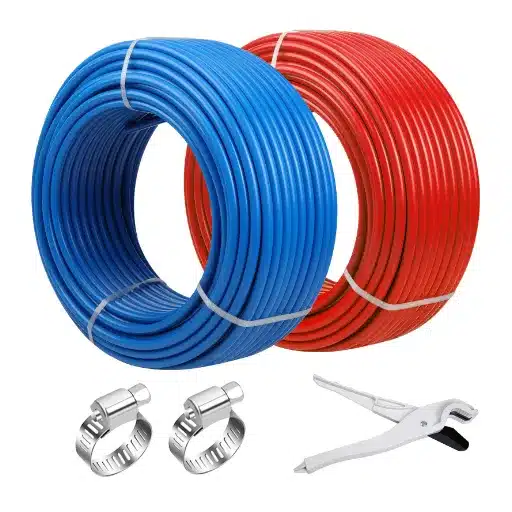
What is PEX Tubing?
PEX tubing refers to cross-linked polyethylene tubing and is flexible, tough, and highly adaptable for use in plumbing, radiant heating, and other water distribution applications. The cross-linked structure allows varying degrees of strength and temperature resistance, so that the tubing is an excellent premium alternative to traditional materials like copper or PVC. PEX is produced by processes that cross- or bond-polymerize polyethylene molecules, resulting in a product that retains flexibility along with increased durability.
Perhaps the best feature of PEX tubing is how easy it is to install. Rather than systems with rigid pipes that require additional fittings to go around a corner or through tight spaces, PEX piping simply bends, making for simpler plumbing systems and fewer leak points. The material is supplied in different sizes, which vary in diameter from 3/8″ to 2″; therefore, residential and commercial setups find use for it. Also, PEX can be connected using common fittings like crimp, clamp, and push-fit methods, which aid in quick assembly and disassembly.
The longevity of PEX tubing and its resistance to corrosion, scale, freezing, and other common problems are the reasons it is highly regarded. It is rated for various temperatures and pressures and will reliably produce for decades. PEX has some insulating features that help keep the water temperature hot or cold for longer, reducing heat loss and efficiency. These qualities, combined with the modest price and low maintenance, have made PEX tubing a leader in modern plumbing and heating systems.
Types of PEX Pipe: PEX-A, PEX-B, and PEX-C
PEX tubing manufacturing is liberation to various techniques, resulting in three main types of the material: PEX-A, PEX-B, and PEX-C. These three main types have things in common: for instance, they are flexible, durable, and corrosion-resistant, but they differ in the manufacturing way and in their performance characteristics, each of which fits particular aspects in real life.
| PEX Type | Manufacturing Method | Key Characteristics | Best Applications |
|---|---|---|---|
| PEX-A | Engel method – high temperature and pressure cross-linking | Most flexible, kink-resistant, heat-repairable | Radiant floor heating, tight installation spaces |
| PEX-B | Silane method – chemical cross-linking after extrusion | Durable, chlorine-resistant, cost-effective | Hot and cold water systems, long-term installations |
| PEX-C | Electron beam cross-linking (radiation) | Lowest cost, stiffest, least flexible | Applications where flexibility is not crucial |
It is best that you understand the distinctions in choosing the appropriate type of PEX for the specific requirements of the project, considering factors such as flexibility, durability, cost, and ease of installation.
Benefits of Using PEX for Potable Water Systems
🔧 Installation Flexibility and Convenience
Being flexible, PEX tubes can be bent along corners or around obstacles without the need for any additional fittings or connectors. This reduces the time and complexity of installation, especially during retrofitting. This flexibility also reduces the possibility of leaks forming at connection sites and thus ultimately gives us a long-term solution.
🛡️ Corrosion and Scale Resistance
Since PEX pipes do not develop corrosion or scale, they provide clean and uninterrupted water for consumption over time. This property extends the pipe’s service life and decreases maintenance costs that would arise from corrosion-related problems.
💰 Cost-Effectiveness
Generally, PEX costs less than traditional materials like copper. Even its installation costs drop as it goes faster and simpler to install. According to industry research, PEX can cut down the total costs for materials and labor by nearly 25-50% when compared to rigid alternatives.
⏰ Durability and Longevity
The durability of PEX is outstanding, with more than 50 years of service life under normal operating conditions. It resists very low or very high temperatures and pressures, suitable for both hot and cold-water systems. As the material can expand and contract fairly well without cracking, it reduces the chances of damage due to freeze and thaw cycles.
🌡️ Improved Thermal Efficiency
Being a good insulator, PEX pipes prevent much heat loss from hot water; hence, they are more energy-efficient than copper pipes. With such attributes, noticeable savings may accumulate for water heating expenses over time, as hot water remains hot for longer periods.
The advantages mentioned explain how PEX, offering a good balance of efficiency, durability, and economy, has become the first choice in modern potable water system installations.
Applications of 1-2 Inch PEX Pipe
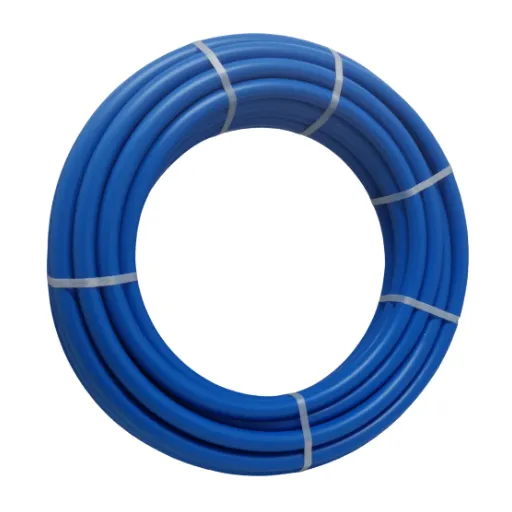
Residential Plumbing Uses
The 1-inch to 2-inch PEX pipe is largely known for its applications in residential plumbing. This pipe is flexible, thus being easy to install over long runs or in awkward spaces, requiring fewer fittings and therefore fewer leak-prone joints. Its flexibility and strength make it really common in house water distribution systems for hot or cold water. The benefits of PEX are that it can withstand a wide temperature range and is considered to be corrosion, scaling, and chlorine resistant.
Technical Performance Specifications:
- Operating Pressure: Up to 160 psi at 73°F
- High Temperature Pressure: 100 psi at 180°F
- Temperature Range: Suitable for both hot and cold water systems
- Expansion Properties: Reduces stress on connection points
Aside from this, it helps reduce capital expenditure incurred, either on the cost of the material itself or on labor; the labor cost depends on how quickly it can be installed according to the installation procedure. These characteristics categorize 1-2 inch PEX pipes as one of the nerve centers of modern-day residential plumbing systems, assuring the industry’s highest standards on account of reliability and durability.
Commercial Applications of PEX Tubing
To increase its popularity as a commercial plumbing application, PEX piping is being marketed for becoming an option for designers and installers for its flexibility and durability, in addition to cost efficiency. The primary application for commercial piping is integrated in hydronics heating and cooling systems. Above-average temperatures in PEX tubing resist scaling, thus heating or chilling water for transport in radiant floor heating or snow melting systems. PEX eliminates much of the installation hassle in these systems because its pliability allows it to follow curves, terrain, and complicated layouts with fewer fittings and joints.
Potable-water delivery systems are the other major commercial use of PEX. Corrosion resistant, it ensures, in the long run, to reliably deliver clean and safe drinking water, especially in those settings in which metallic pipes would degrade. Furthermore, its ability to expand and contract reduces the risk of pipe bursting in freezing temperature regions, which can be a concern in large commercial or multi-residential buildings.
In commercial fire suppression systems, PEX is again heavily utilized. Its high-pressure resistance and flame-retardant qualities make it work effectively in wet and multipurpose fire sprinkler systems. Its ease of integration with existing infrastructure enhances its appeal for retrofitting older commercial buildings. These different applications speak to the versatility of PEX tubing and position it as a valuable commodity towards fulfilling the challenging needs of modern commercial plumbing and HVAC systems.
Heating Systems and PEX Pipe
Due to its versatile nature, long life, and thermal efficiency, PEX pipes have found their way into modern heating systems. One of the most important uses for it is in hydronic radiant heating systems, wherein hot water is transported through a system of PEX pipes under the floor. This provides steady and energy-efficient heat since the pipe’s thermal conductivity is so good that heat is evenly distributed throughout the living area.
Energy Efficiency Benefits:
Temperature Resistance: PEX withstands temperatures above 180°F (82°C)
Energy Savings: Up to 20% reduction in total energy consumption compared to forced-air systems
Compatibility: Works with conventional boilers, geothermal, and solar thermal systems
Considering the present utilization trends, PEX installations in hydronic heating systems may reduce the total energy consumption by 20% as opposed to traditional forced-air systems. Alongside enhanced performance, due to the simple handling of PEX and less installation time, PEX pipe is reckoned to have a price edge in residential, commercial, and industrial heating applications.
Installation Tips for PEX Tubing
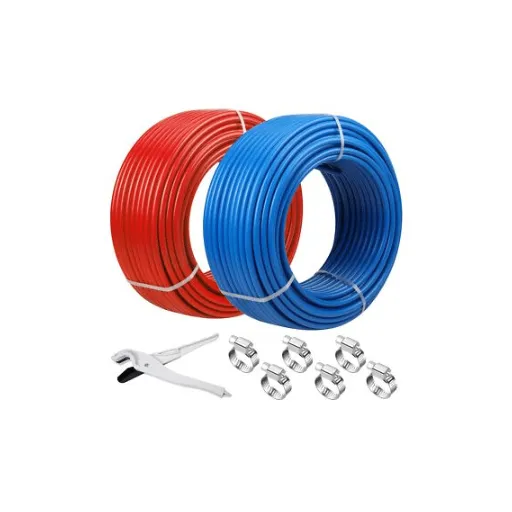
Essential Tools for PEX Pipe Installation
Several specialized tools are employed during a PEX pipe installation to guarantee accuracy, efficiency, and long-term performance:
🔪 PEX Cutter
The PEX cutter must have a very fine edge to avoid the formation of burrs while cutting PEX tubing. Different PEX end fittings and finishing of surfaces ensure that seals form well during the connection stage so that they are leak-proof and reliable.
🔧 Crimping Tools
Crimping tools are required to work with copper crimp rings to secure a connection of PEX tubing and fittings. Make sure the crimping tool you intend to use can handle the tubing size you will be using to prevent improper sealing.
📏 Pipe Expansion Tools
For working with PEX-A tubing, pipe expansion tools are required; they expand the end of a pipe to allow the fitting, which contracts onto it, to form a tight, leak-proof connection.
🔩 Pipe Fittings
To construct the required layout and guarantee secure connections, consider different types of fittings, such as elbows, tees, and couplings. Brass and polymer-based options are both available to choose from, depending on the case at hand and the cost of either one.
📐 Go/No-Go Gauge
This gauge is needed to check the correctness of the crimper or clamping. An accurate seal minimizes leak risk and meets industry standards.
🔗 Utility Accessories
Accessories like pipe clamps, support brackets, and utility outlet boxes are used to brace the whole structure, preventing any movement or longitudinal stress on the connections or tubing over time.
All these tools, used rightly, will make the installation process smoother and make the PEX systems worthy of all applications. Remaining updated with recent advances in theories of PEX and associated tools will provide even better functioning and longevity of a PEX system.
Common Mistakes to Avoid When Installing PEX
⚠️ Critical Installation Errors to Avoid:
- Improper Expansion or Crimping of Connections: This is one of the most frequently made errors during the connection and installation phase. An improper expansion or crimping of PEX tubing may lead to leakage, diminish the system efficiency, or cause total system failure with time. Use tools recommended by manufacturers, and check all connections for tightness and specification compliance before going forward.
- Lack of Proper Support: Neglecting proper support for PEX piping can cause unnecessary stress, sagging, and eventual damage to the piping over time. Support brackets or hangers should be installed in appropriate intervals as dictated by recommended spacing criteria based on pipe size and application to keep the piping aligned whilst reducing the applied strain.
- Exposure to UV Light: PEX tubing is not meant for prolonged exposure to ultraviolet (UV) light. Even short exposure to direct sunlight during installation will weaken the material, thereby eventually compromising its structural integrity. Ensure the PEX tubing is either stored or installed under shade or an overed area. Use UV protective coats if the installation is out in the open.
- Improper Pipe Sizing: Having the wrong pipe sizes for given applications could restrict water flow or create excess pressure in the system. It is a requirement that pipe diameters be determined in consideration of water demand and flow rates to make them perform efficiently and to avoid costly repairs.
- Use of Non-Compatible Fittings or Tools: Another common problem occurs when the fittings or the tools are incompatible with the PEX line. Always make sure that all components and tools are suitable for the PEX you are using: PEX-A, PEX-B, or PEX-C. Otherwise, you risk weakening the connections and compromising their durability.
- Skipping Protective Measures in Freezing Conditions: Although PEX is more resistant to freezing than conventional types, it is certainly not immune to damage caused by extreme lows in temperature. Insulation of pipes in exposed or unheated areas is an essential measure to prevent freezing and the consequent rupturing in the cold months of the year.
By making proper installation practices a priority and exposing these mistakes, both professionals and DIYers can make sure PEX plumbing systems perform well through time, efficiency, and reliability.
Techniques for Efficient PEX Plumbing
✅ Best Practices for Professional Installation:
- Plan the Layout Strategically: A truly efficient PEX plumbing system starts with an intelligent layout design. Use manifold systems to ensure water distribution is centralized, so all fixtures get the same pressure, saving on the materials used by the whole system. In hot-water lines, keep lines as close to each other as possible to reduce heat loss, while pipe runs are to be designed in a way that eliminates unnecessary bends and fittings to ensure the best water flow and least maintenance.
- The Right Tools and Fittings: Use the right tools and fittings that maintain structural integrity within an application of PEX systems. In other words, make sure the expansion tools and crimping tools you use correspond to your PEX system (PEX-A, PEX-B, or PEX-C). Always select fittings manufactured from quality brass or polymer to maintain a secure connection and avoid the risk of long-term leaks.
- Insulate PEX Pipes: Always insulate the PEX pipes during installation when in cold or inconsistent environmental conditions to maximize system efficiency and reliability. Although PEX is considered more freeze-resistant as compared to copper, the right insulation for pipes protects against freezing and further aids heat efficiency by reducing heat transfer losses in hot water lines.
- Allow for Thermal Expansion: It is also important to remember that PEX tubing will expand and contract lengthwise with changes in temperature while installing it. In long pipe runs, leave some slack or loops where necessary to prevent undue stress from thermal expansion while still properly securing the pipes.
- Pressure Testing Before Use: Performing a pressure test during the installation procedure before commissioning is an absolute requirement. Fill with water or air, and pressurize to the level recommended by the system manufacturer, typically about 100 psi to 150 psi. This test will identify leaks or weak connections so they can be rectified before being put into use.
- Follow Local Plumbing Codes: It is mandatory that the local building and plumbing codes be followed to ensure that PEX installations remain legal and optimal. These codes generally specify minimum standards for pipe sizing, valve locations, freeze protection, etc. Complying strictly with these regulations reduces the chances of infringement and also ensures performance over a long time.
Incorporating these high-level strategies enables the professional to design durable, functionally efficient PEX plumbing systems according to specific operational requirements.
Compatibility and Fittings
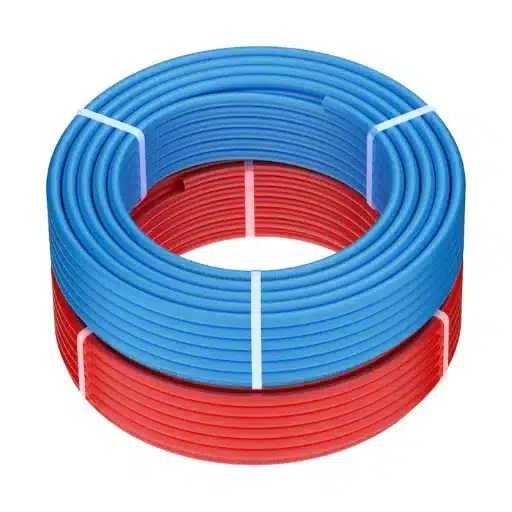
Types of Fittings Compatible with PEX Pipe
PEX pipes use many varieties of fittings that work toward strong connections while keeping the system intact and free to work. The main types of fittings that are used with the PEX piping systems are:
| Fitting Type | Description | Best Use Case |
|---|---|---|
| Crimp Fittings | Uses a copper or stainless steel crimp sleeve compressed with a crimping tool | Most common, long-lasting leak-proof joints |
| Clamp (Cinch) Fittings | Stainless steel cinch clamps secured with a cinch tool | Quick installation in tight spaces |
| Push-to-Connect Fittings | Tool-free connections with O-ring seals | Quick repairs and simple installations |
| Expansion Fittings | Requires an expansion tool to open the pipe before fitting insertion | Best for PEX-A with shape memory features |
| Compression Fittings | Uses a nut and ferrule ring for a tight seal | High-pressure or industrial applications |
| Threaded Adapters | One end for PEX, the other end with a threaded connection | Conversion to metallic threaded systems |
Each fitting has its own role inside the PEX network and should be chosen depending on the needs of the particular application, i.e., pressure ratings, temperature tolerances, and regulatory compliance. Frequent inspections will go a long way in keeping with installation manufacturers’ guidelines to ensure the reliability and longevity of PEX installations.
Using Oxygen Barrier PEX for Heating Applications
Oxygen Barrier PEX is also called PEX with an external layer of ethylene vinyl alcohol (EVOH) and is developed for hydronic heating systems. The primary benefit of this product is that it prevents the ingress of oxygen molecules through the tubing walls, which causes corrosion of metallic components such as boilers, pumps, and valves in closed-loop systems. Such a barrier provides stability to the system and thereby increases its operational life while also protecting crucial equipment from oxidative damage.
Technical Specifications for Oxygen Barrier PEX:
- Temperature Range: 180°F to 200°F operating capability
- Operating Pressure: 80 psi in hydronic systems
- Standards Compliance: ASTM F876 and ASTM F877
- Applications: Radiant floor heating, baseboard heating, snowmelt systems
Oxygen Barrier PEX requires careful consideration by the professional in relation to high-efficiency boilers and multi-zone heating configurations. Heat distribution and energy efficiency across the system have to be designed and realized in conjunction with the use of manifolds and insulation. Compliance with local building codes and guidelines issued by bodies such as the Uniform Plumbing Code (UPC) or International Plumbing Code (IPC) is also fundamental for ensuring that systems stand the best chance of maximized performance while remaining legally compliant.
Maintenance will go down, the system life will be extended, and the system’s performance will be improved by integrating Oxygen Barrier PEX into the new heating designs; this, in fact, makes this special tubing the foremost choice in residential and commercial hydronic heat applications.
Connecting PEX to Other Pipe Materials
A wide array of options exists when it comes to installing PEX tubing; thus, choosing individual system components with care and installing them properly are paramount. The changes from PEX to other materials usually go through threaded adapters, push-to-connect fittings, or transition couplings, all of which are capable of accommodating the differences between material properties, such as expansion rates and pressure tolerances, through which mechanical failure might occur.
Connection Methods by Material Type:
- Copper to PEX: Brass or plastic fittings with crimp ring or clamp systems for a watertight seal
- Galvanized Steel to PEX: Dielectric unions or transition fittings to prevent galvanic corrosion
- PVC to PEX: Special barbed fittings or pipe adhesives approved for both materials
- Push-Fit Technology: Modern connections that reduce installation time while ensuring proper installation
In any installation, there should be adherence to the manufacturer’s guidelines, material specifications, and local plumbing codes. The incorrect connection or the incompatibility of fittings will adversely affect the system and warranty. With the advent of newer connection methods, such as push-fit technology, installation takes less time while also providing confidence that correct installation was achieved. Hence, these attractive methods are gaining acceptance throughout the DIY and professional plumbing business.
Maintenance and Longevity of PEX Systems
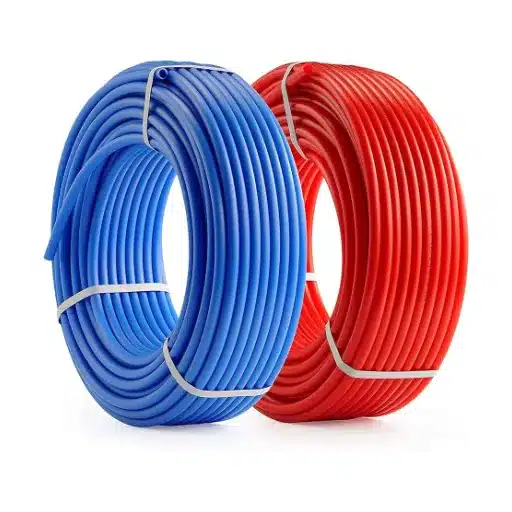
Best Practices for PEX Pipe Maintenance
Maintaining some important principles will go a long way in assuring the longevity and consistent performance of a PEX piping system. Inspections should always take precedence; examine areas of pipe that are accessible for signs of wear, leakage, or damage. Discolorations, bulging, or even cracking signs are evidence of stress or are about to fail under the influence of environmental conditions or at times due to faulty installation. Likewise, fittings and other connection points should be checked for looseness or compromise, as any loss of integrity could result in leaks or pressure issues.
🔍 Essential Maintenance Checklist:
- Regular visual inspection of accessible pipe areas
- Check for discoloration, bulging, or cracking
- Examine fittings and connection points for looseness
- Protect pipes from temperature extremes
- Insulate pipes in unconditioned spaces
- Prevent prolonged UV exposure
- Monitor water quality and consider filtration
- Avoid chemical cleaners not approved for PEX
On the other hand, protecting the pipes from temperature extremes is one factor that makes another set of crucial maintenance procedures for PEX piping systems. Although PEX pipe has an inherent flexibility and resistance to freezing, I try to always insulate pipes running through unconditioned spaces such as basements, crawlspaces, and attics. Such insulation helps prevent pipe freezing in cold weather months and enhances energy efficiency by reducing heat loss in hot water lines. Another important factor is making sure that PEX pipes do not get exposed to intense sunlight for prolonged durations, as UV rays will cause material degradation in due course of time.
Lastly, I recommend monitoring water quality in your plumbing system so as to lower the rate of wear on PEX pipes. Hard water, being rich in minerals, causes scaling inside the pipes and affects both their flow efficiency and durability. Should you be aware that your water supply contains very high levels of these minerals, it would be worthwhile considering installing a water softener to curtail this problem. Similarly, refraining from using chemical cleaners or additives that are not expressly approved for PEX systems would help maintain the pipe’s integrity in the long term.
Signs of Wear and When to Replace PEX Tubing
PEX piping is designed for durability and long-lasting quality, often enduring for over a couple of decades under ideal working conditions. There are, however, a few indications of wear and tear that require maintenance at proper intervals or, at times, altogether replace the tubing. Common symptoms that one may watch out for include visible cracking, discoloration of the tubing, or an unusual odor emanating from the water it carries. Often, cracking can indicate the presence of environmental stress or mechanical damage during installation due to improper procedures or exposure of tubing to UV light during storage or installation.
⚠️ Warning Signs Requiring Immediate Attention:
- Visible cracking or splits in tubing
- Discoloration or unusual odors in water
- Loss of water pressure throughoutthe system
- Leaking at connection points
- Exposure damage from UV light
- System operating beyond pressure ratings (>80 psi)
- High chlorine levels are accelerating degradation
Also, a loss in general water pressure or the occurrence of leaking may pinpoint the real problem within the piping system. These kinds of problems include fittings slowly coming loose over a period of time or from places where the tubing has undergone excessive heating beyond its rated temperature. According to industry data, conditions where water pressure exceeds 80 psi or where water is highly chlorinated can accelerate PEX piping’s deterioration. It should be noted that the compositions of some older PEX materials may be inimical to oxygen-rich systems or high chlorine levels, hence premature wear.
The replacement of PEX tubing depends on the type of PEX (i.e., PEX-a, PEX-b, or PEX-c), its exposure conditions, and the quality of its installation. While PEX systems are, in general, rated to last for 25 to 50 years under normal conditions, one should preferably undertake periodic visual inspection of exposed piping and take corrective action when the need arises. Having a professional plumber inspect the system time and again will also facilitate early discovery of any problems that could lead to expensive repairs or water damage.
Ensuring Long-Term Performance of PEX Plumbing
The PEX plumbing systems work properly and reliably if they are installed following their codes of practice or guidelines. Proper installation is the next very important consideration; any strain put on the tubing or improper connections might compromise the integrity of the system. Tubing should be held in place with the correct fitting and clamps as recommended by a reputable manufacturer to safeguard it from leaks and system failures that might occur over the years. The tubing should also be protected against UV rays. PEX tubing after long exposure to sunlight will fade and decompose, along with its strength and performance.
🛡️ Long-Term Performance Factors:
- Proper Installation: Follow manufacturer guidelines and codes
- UV Protection: Shield from prolonged sunlight exposure
- Temperature Management: Stay within rated specifications
- Water Quality Control: Monitor chlorine levels and chemical exposure
- Regular Testing: Periodic thermal and pressure testing
- Professional Inspections: Scheduled system evaluations
Other aspects of temperature considerations are also highly important for PEX systems. A quick way of describing how PEX resists freezing is that it does not freeze in that respect, and it does not burst. Nevertheless, insulation is important in cold climates. Temperatures above the maximum rated specifications of the system should also be prevented if structural integrity is to be maintained.
The other important factor is water quality. Chlorine in water at very high concentrations or water with a slight concentration of aggressive chemicals can accelerate PEX tubing degradation over time. To prevent or reduce this effect on the PEX tubing, either employ a water filter system or periodic water quality analysis. Also, periodic thermal and pressure testing of plumbing might reveal some weak points that need to be repaired. Proper installation, good maintenance, and avoidance of environmental and chemical exposure will surely extend the performance life of PEX plumbing systems.
Frequently Asked Questions (FAQ)
❓ What are the advantages of 1 to 2-inch PEX pipe in water plumbing?
1 to 2-inch PEX pipe is highly efficient in water plumbing, having flexibility, resistance to scaling and chlorine, and ease of installation. They can expand and contract to temperature changes, making them less prone to cracking under extreme conditions. Moreover, PEX fittings are easy to join, making these pipes suitable for both commercial and residential plumbing.
❓ How does a 1-2 inch PEX pipe stand against PEX-A and PEX-B pipe?
Pex-a pipe has better flexibility and is better at resisting freeze damage, whereas pex-b pipe is rigid and cheaper. They might be used interchangeably based on the requirements of your plumbing project. When dealing with 1-2 inch PEX pipe, your choice between PEX-A and PEX-B may depend upon the pressure levels and installation techniques required in your particular application.
❓ What lengths do 1-2 inch PEX pipe rolls come in?
Typically, 1-2 inch PEX pipe is rolled in lengths of various sizes, typically including a couple of options such as x 100 feet or x 200 feet. These convenient lengths allow for easy handling and installation in various plumbing projects, whether it’s a residential or commercial hot and cold water system.
❓ Is 1-2 inch PEX suitable for radiant floor heating?
Yes, a 1-2 inch PEX pipe is used for radiant floor heating. The flexibility of PEX makes installations easier in intricate layouts; thus, it delivers hot water efficiently throughout the system by resisting required pressure levels.
❓ What kind of fittings do 1-2 inch PEX pipes take?
There are many PEX fittings compatible with 1-2 inch PEX pipe, including crimp fittings, clamp rings, and SharkBite push-to-connect fittings, ensuring a secure placement with other plumbing fixtures and leak-proof installation for both hot and cold water plumbing.
❓ How do I determine the outer diameter of a 1-2 inch PEX pipe?
The OD (outer diameter) of 1-2 inch PEX pipe shall mostly be slightly above 1 inch for a 1-inch pipe and slightly more than 2 inches for a 2-inch pipe. This dimension is very crucial for choosing the right fittings and making sure that they fit other plumbing components in your system.
❓ Can I use a 1-2 inch PEX pipe for hot and cold water?
Yes, 1-2 inch PEX is suitable for both hot and cold water plumbing purposes. Its construction makes it very potent to resist high-temperature water, making it an excellent choice for a wide range of plumbing needs in either commercial or residential setups.
❓ What pressure does a 1-2 inch PEX pipe withstand?
Typically, 1-2 inch PEX pipe may bear pressures of 80-100 PSI, depending on the kind and manufacturer. This allows it to be used in various plumbing installations, thus making it highly reliable under any situation of stress. For precise pressure levels, always check the specification from your manufacturer.
References
📚 Research Sources and Technical Documentation:
- Corrosion on upstream metal plumbing components impacts downstream PEX pipe surface deposits and degradation.
The discussion on corrosion and degradation of PEX pipes is published on ScienceDirect. - Failures in Plumbing/Piping/Tubing
A chapter from Taylor & Francis offering perspectives on failures encountered by plumbing systems, including PEX pipes. - PEX Plumbing Material Can Contribute Chemical/Solvent Odor to Drinking Water
Research at Virginia Tech into the chemical contribution of PEX pipes to drinking water.
🔧 Ready to Upgrade Your Plumbing System?
PEX tubing offers unmatched versatility, durability, and cost-effectiveness for modern plumbing and heating applications. Whether you’re planning a new installation or upgrading an existing system, understanding the benefits and proper installation techniques of 1-2 inch PEX pipe will ensure long-term reliability and performance for your project.




